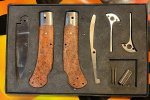DanF
Knifemaker / Craftsman / Service Provider
- Joined
- Apr 17, 2017
- Messages
- 1,507
The BladeForums.com 2024 Traditional Knife is available! Price is $250 ea (shipped within CONUS).
Order here: https://www.bladeforums.com/help/2024-traditional/
bronze bushing will solve that problem , and it's easy to replace when the time comesI have not got one or made one yet, so take this with a pinch of salt.
It depends on the type of jig, if its the simple rotate on the pivot pin around the cutter type, then I can forsee a force exerted on the pin and transfered to the hole, due to the action of the cutter, which could accelerate deformation and wear on the hole in an aluminum baseplate, It will work but for how long only experience will prove. A hardened piece of tool steel will last. But as with most designs you will see ways to improve the contraption and end up making another anyway. So aluminum, in this scenario, will suffice until the design is finalised. Then use tool steel.

I don't do a lot of folders, but I usually use a thin phosphor bronze washer to separate the blade and the liner. It is simpler than relieving the liners.
Maybe it's not the right place, but I'll mention it anywayI use 0.1mm ~ 4/1000 inch washers.
My HT guy makes them for me
Edit: and I use spring steel 0.2 thicker then the blade steel

I think that one is spare if ever other one ever break ?Not sure of the manufacturers intention, but both springs equal the thickness of the blade and the “release” piece. Combined, they seem to give the same pressure as I have experienced on bought lockbacks. I would think that just one spring may try to twist a bit, but I am not sure of that, I can only speculate with my limited knowledge of lockbacks.
If anyone else knows feel free to speak up please.
Edit to ad, both springs are the same thickness, one is just shoved down deeper in the foam
